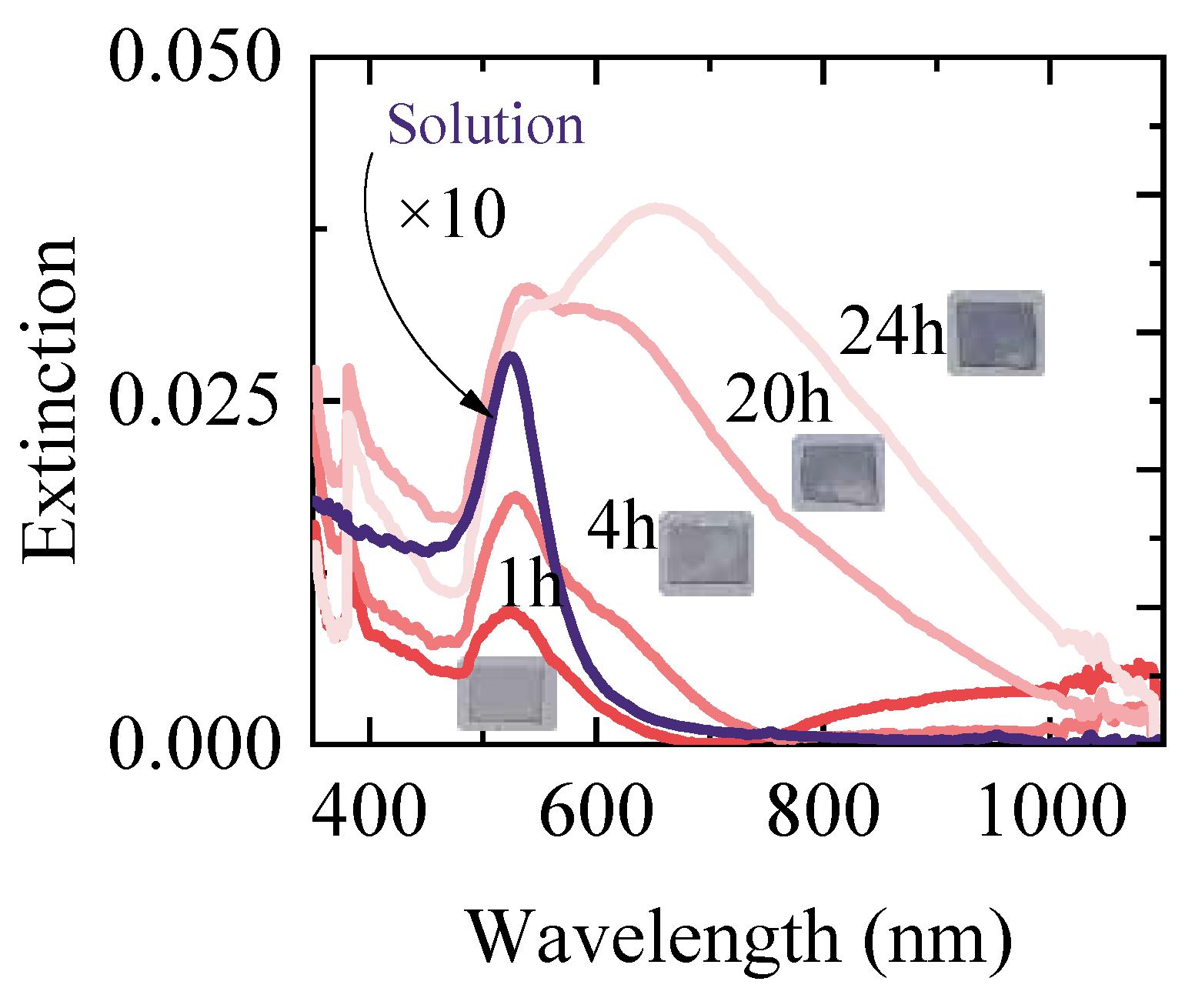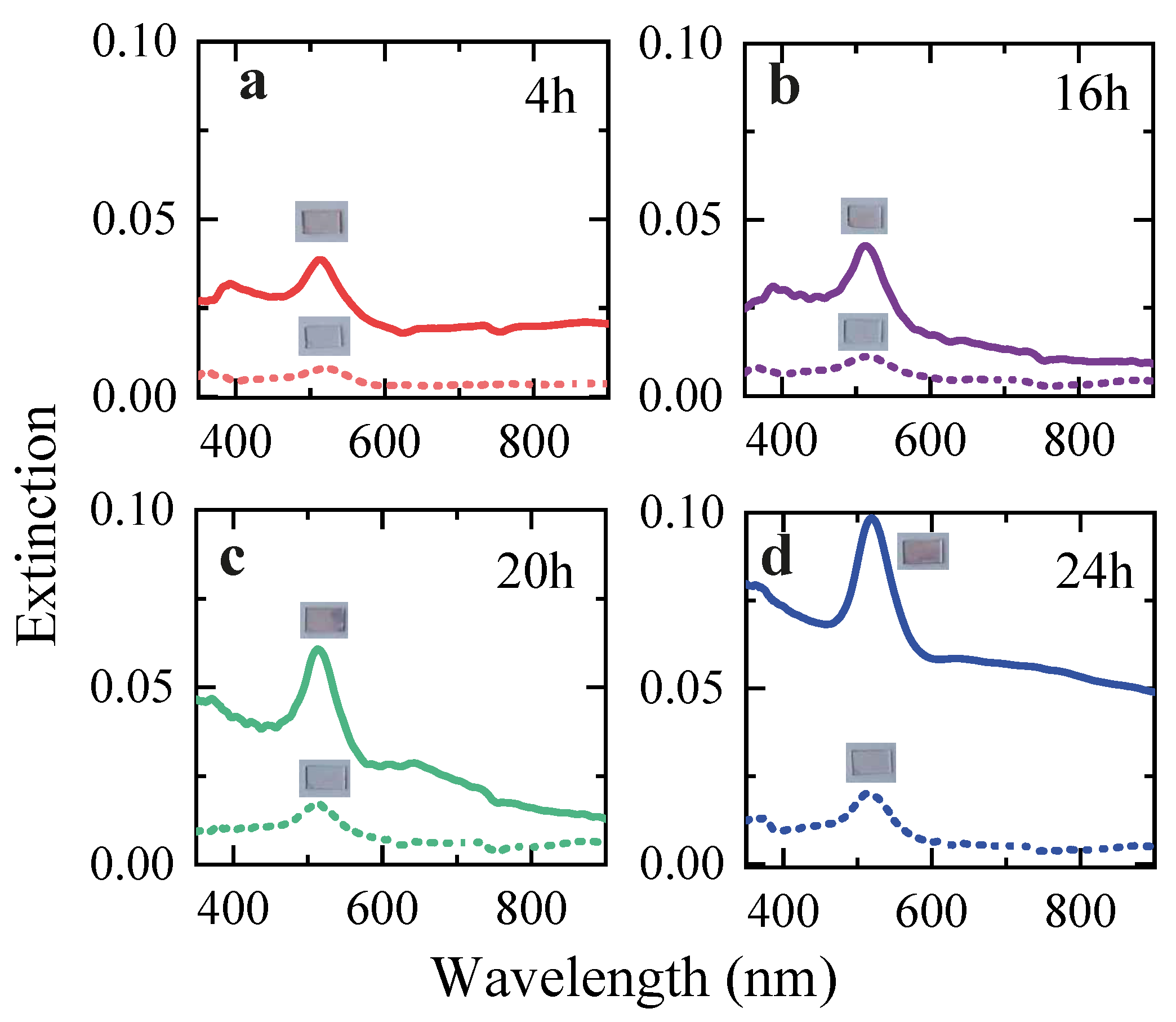AI-Assisted Plasmonic Coupling Analysis of Spherical Gold Nanoparticles on Substrate
Abstract
1. Introduction
2. Materials and Methods
2.1. Synthesis of Gold Nanoparticles
2.2. Deposition of Nanoparticles on Functionalized Glass Substrate
3. Results and Discussion
4. Neural Network Architecture and Hyperparameter Optimization
4.1. Data Collection and Processing
4.2. Model Architecture
4.3. Optimization and Hyperparameter Searching
5. Conclusions
Author Contributions
Funding
Institutional Review Board Statement
Informed Consent Statement
Data Availability Statement
Conflicts of Interest
References
- Alekseeva, A.; Bogatyrev, V.; Khlebtsov, B.; Mel’Nikov, A.; Dykman, L.; Khlebtsov, N. Gold nanorods: Synthesis and optical properties. Colloid J. 2006, 68, 661–678. [Google Scholar] [CrossRef]
- Becerril-Castro, I.B.; Calderon, I.; Pazos-Perez, N.; Guerrini, L.; Schulz, F.; Feliu, N.; Chakraborty, I.; Giannini, V.; Parak, W.J.; Alvarez-Puebla, R.A. Gold Nanostars: Synthesis, Optical and SERS Analytical Properties. Anal. Sens. 2022, 2, e202200005. [Google Scholar] [CrossRef]
- Dadadzhanov, D.R.; Vartanyan, T.A.; Dadadzhanova, A.I.; Karabchevsky, A. Surface-enhanced near-infrared absorption (SENIRA) of C-H and N-H groups with gold nanoarray. In Proceedings of the Quantum Sensing and Nano Electronics and Photonics XVII; Razeghi, M., Lewis, J.S., Khodaparast, G.A., Khalili, P., Eds.; International Society for Optics and Photonics, SPIE: Pune, India, 2020; Volume 11288, p. 1128816. [Google Scholar] [CrossRef]
- Dadadzhanov, D.R.; Vartanyan, T.A.; Karabchevsky, A. Vibrational overtones spectroscopy enabled by plasmonic nanoantennas. In Proceedings of the Plasmonics: Design, Materials, Fabrication, Characterization, and Applications XVI; SPIE: Pune, India, 2018; Volume 10722, pp. 112–116. [Google Scholar]
- Kuznetsova, V.; Kadar, A.; Gaenko, A.; Er, E.; Ma, T.; Whisnant, K.G.; Ma, J.; Ni, B.; Mehta, N.; Kim, J.Y.; et al. Graph–Property Relationships for Complex Chiral Nanodendrimers. ACS Nano 2025, 19, 6095–6106. [Google Scholar] [CrossRef] [PubMed]
- Sapunova, A.A.; Yandybaeva, Y.I.; Zakoldaev, R.A.; Afanasjeva, A.V.; Andreeva, O.V.; Gladskikh, I.A.; Vartanyan, T.A.; Dadadzhanov, D.R. Laser-Induced Chirality of Plasmonic Nanoparticles Embedded in Porous Matrix. Nanomaterials 2023, 13, 1634. [Google Scholar] [CrossRef]
- Zhu, H.; Yuan, X.; Yao, Q.; Xie, J. Shining photocatalysis by gold-based nanomaterials. Nano Energy 2021, 88, 106306. [Google Scholar] [CrossRef]
- Jagannath, G.; Eraiah, B.; NagaKrishnakanth, K.; Rao, S.V. Linear and nonlinear optical properties of gold nanoparticles doped borate glasses. J. Non-Cryst. Solids 2018, 482, 160–169. [Google Scholar] [CrossRef]
- Pasparakis, G. Recent developments in the use of gold and silver nanoparticles in biomedicine. WIREs Nanomed. Nanobiotechnol. 2022, 14, e1817. [Google Scholar] [CrossRef]
- Maleeva, K.; Dadadzhanov, D.; Palekhova, A.; Kaliya, I.; Tkach, A.; Baranov, A.; Bogdanov, K. SERS substrates based on polymer-protected self-assembled plasmonic films with gold nanoparticles as enhancing element of a microfluidic sensor. Opt. Mater. 2023, 146, 114581. [Google Scholar] [CrossRef]
- Dadadzhanov, D.R.; Gladskikh, I.A.; Baranov, M.A.; Vartanyan, T.A.; Karabchevsky, A. Self-organized plasmonic metasurfaces: The role of the Purcell effect in metal-enhanced chemiluminescence (MEC). Sens. Actuators B Chem. 2021, 333, 129453. [Google Scholar] [CrossRef]
- Geddes, C.D.; Lakowicz, J.R. Metal-enhanced fluorescence. J. Fluoresc. 2002, 12, 121–129. [Google Scholar] [CrossRef]
- Wu, W.T.; Chen, C.H.; Chiang, C.Y.; Chau, L.K. Effect of Surface Coverage of Gold Nanoparticles on the Refractive Index Sensitivity in Fiber-Optic Nanoplasmonic Sensing. Sensors 2018, 18, 1759. [Google Scholar] [CrossRef]
- Nehl, C.L.; Liao, H.; Hafner, J.H. Optical Properties of Star-Shaped Gold Nanoparticles. Nano Lett. 2006, 6, 683–688. [Google Scholar] [CrossRef] [PubMed]
- Hao, E.; Schatz, G.C.; Hupp, J.T. Synthesis and Optical Properties of Anisotropic Metal Nanoparticles. J. Fluoresc. 2004, 14, 331–341. [Google Scholar] [CrossRef] [PubMed]
- Sánchez-Iglesias, A.; Pastoriza-Santos, I.; Pérez-Juste, J.; Rodríguez-González, B.; Garcia de Abajo, F.J.; Liz-Marzán, L.M. Synthesis and Optical Properties of Gold Nanodecahedra with Size Control. Adv. Mater. 2006, 18, 2529–2534. [Google Scholar] [CrossRef]
- Rechberger, W.; Hohenau, A.; Leitner, A.; Krenn, J.; Lamprecht, B.; Aussenegg, F. Optical properties of two interacting gold nanoparticles. Opt. Commun. 2003, 220, 137–141. [Google Scholar] [CrossRef]
- Manoccio, M.; Esposito, M.; Passaseo, A.; Cuscunà, M.; Tasco, V. Focused Ion Beam Processing for 3D Chiral Photonics Nanostructures. Micromachines 2020, 12, 6. [Google Scholar] [CrossRef]
- Gladskikh, I.A.; Toropov, N.A.; Dadadzhanov, D.R.; Baranov, M.A.; Gladskikh, A.A.; Mirzoyan, G.; Markovich, G.; Vartanyan, T.A. Laser-Based Reshaping of Self-Organized Metasurfaces of Supported Ag Nanoparticles for Encoding Tunable Linear Dichroism Patterns. ACS Appl. Nano Mater. 2024, 7, 11342–11349. [Google Scholar] [CrossRef]
- Phengdaam, A.; Phetsang, S.; Jonai, S.; Shinbo, K.; Kato, K.; Baba, A. Gold nanostructures/quantum dots for the enhanced efficiency of organic solar cells. Nanoscale Adv. 2024, 6, 3494–3512. [Google Scholar] [CrossRef]
- Cho, N.H.; Kim, Y.B.; Lee, Y.Y.; Im, S.W.; Kim, R.M.; Kim, J.W.; Namgung, S.D.; Lee, H.E.; Kim, H.; Han, J.H.; et al. Adenine oligomer directed synthesis of chiral gold nanoparticles. Nat. Commun. 2022, 13, 3831. [Google Scholar] [CrossRef]
- Van Gordon, K.; Baúlde, S.; Mychinko, M.; Heyvaert, W.; Obelleiro-Liz, M.; Criado, A.; Bals, S.; Liz-Marzán, L.M.; Mosquera, J. Tuning the Growth of Chiral Gold Nanoparticles Through Rational Design of a Chiral Molecular Inducer. Nano Lett. 2023, 23, 9880–9886. [Google Scholar] [CrossRef]
- Sargazi, S.; Laraib, U.; Er, S.; Rahdar, A.; Hassanisaadi, M.; Zafar, M.N.; Diez-Pascual, A.M.; Bilal, M. Application of Green Gold Nanoparticles in Cancer Therapy and Diagnosis. Nanomaterials 2022, 12, 1102. [Google Scholar] [CrossRef] [PubMed]
- Sastry, M.; Rao, M.; Ganesh, K.N. Electrostatic Assembly of Nanoparticles and Biomacromolecules. Acc. Chem. Res. 2002, 35, 847–855. [Google Scholar] [CrossRef] [PubMed]
- Adamczyk, Z.; Morga, M.; Nattich-Rak, M.; Sadowska, M. Nanoparticle and bioparticle deposition kinetics. Adv. Colloid Interface Sci. 2022, 302, 102630. [Google Scholar] [CrossRef]
- Montaño-Priede, J.L.; Sanroman-Iglesias, M.; Zabala, N.; Grzelczak, M.; Aizpurua, J. Robust Rules for Optimal Colorimetric Sensing Based on Gold Nanoparticle Aggregation. ACS Sens. 2023, 8, 1827–1834. [Google Scholar] [CrossRef]
- Abdullah, A.; Altaf, M.; Khan, H.I.; Khan, G.A.; Khan, W.; Ali, A.; Bhatti, A.S.; Khan, S.U.; Ahmed, W. Facile room temperature synthesis of multifunctional CTAB coated gold nanoparticles. Chem. Phys. 2018, 510, 30–36. [Google Scholar] [CrossRef]
- ITMO University. Mie/Theory Spectrum Calculator. Available online: https://physics.itmo.ru/ru/mie#/spectrum (accessed on 26 May 2025).
- Gutiérrez, M.V.; Scarpettini, A.F. Kinetic and plasmonic properties of gold nanorods adsorbed on glass substrates. Colloid Interface Sci. Commun. 2019, 33, 100213. [Google Scholar] [CrossRef]
- Behrens, S.H.; Grier, D.G. The charge of glass and silica surfaces. J. Chem. Phys. 2001, 115, 6716–6721. [Google Scholar] [CrossRef]
- Kelesidis, G.A.; Gao, D.; Starsich, F.H.; Pratsinis, S.E. Light Extinction by Agglomerates of Gold Nanoparticles: A Plasmon Ruler for Sub-10 nm Interparticle Distances. Anal. Chem. 2022, 94, 5310–5316. [Google Scholar] [CrossRef] [PubMed]
- Saison-Francioso, O.; Lévêque, G.; Akjouj, A.; Pennec, Y. Theoretical Study of Gold Nanoparticles Randomly Dispersed on a Dielectric/Gold Substrate. ACS Omega 2023, 8, 21493–21505. [Google Scholar] [CrossRef]
- Saini, R.K.; Sharma, A.K.; Agarwal, A.; Prajesh, R. Near field FEM simulations of plasmonic gold nanoparticle based SERS substrate with experimental validation. Mater. Chem. Phys. 2022, 287, 126288. [Google Scholar] [CrossRef]
- Naskar, B. Micellization and Physicochemical Properties of CTAB in Aqueous Solution: Interfacial Properties, Energetics, and Aggregation Number at 290 to 323 K. Colloids Interfaces 2025, 9, 4. [Google Scholar] [CrossRef]
- Jain, K.; Mehandzhiyski, A.Y.; Zozoulenko, I.; Wågberg, L. PEDOT:PSS nano-particles in aqueous media: A comparative experimental and molecular dynamics study of particle size, morphology and z-potential. J. Colloid Interface Sci. 2021, 584, 57–66. [Google Scholar] [CrossRef] [PubMed]
- Leonov, N.B.; Gladskikh, I.A.; Starovoytov, A.A. Effect of media on plasmon resonance of silver nanoparticles. Appl. Phys. A 2023, 129, 430. [Google Scholar] [CrossRef]
- Jenkins, J.A.; Zhou, Y.; Thota, S.; Tian, X.; Zhao, X.; Zou, S.; Zhao, J. Blue-Shifted Narrow Localized Surface Plasmon Resonance from Dipole Coupling in Gold Nanoparticle Random Arrays. J. Phys. Chem. C 2014, 118, 26276–26283. [Google Scholar] [CrossRef]
- Yoon, S. Controlled assembly of gold nanoparticles: Methods and plasmon coupling properties. Bull. Korean Chem. Soc. 2024, 45, 689–698. [Google Scholar] [CrossRef]
- Paszke, A. Pytorch: An imperative style, high-performance deep learning library. arXiv 2019, arXiv:1912.01703. [Google Scholar]
- Akiba, T.; Sano, S.; Yanase, T.; Ohta, T.; Koyama, M. Optuna: A Next-generation Hyperparameter Optimization Framework. In Proceedings of the 25th ACM SIGKDD International Conference on Knowledge Discovery & Data Mining, KDD ’19, New York, NY, USA, 4–8 August 2019; pp. 2623–2631. [Google Scholar] [CrossRef]
- Pedregosa, F.; Varoquaux, G.; Gramfort, A.; Michel, V.; Thirion, B.; Grisel, O.; Blondel, M.; Prettenhofer, P.; Weiss, R.; Dubourg, V.; et al. Scikit-learn: Machine learning in Python. J. Mach. Learn. Res. 2011, 12, 2825–2830. [Google Scholar]
- Chen, T.; Guestrin, C. Xgboost: A scalable tree boosting system. In Proceedings of the 22nd ACM SIGKDD International Conference on Knowledge Discovery and Data Mining, San Francisco, CA, USA, 13–17 August 2016; pp. 785–794. [Google Scholar]






| Model | R2 | RMSE | MSE | MAE |
|---|---|---|---|---|
| Ridge (optimized) | 0.6162 | 0.1327 | 0.0176 | 0.0952 |
| Lasso (optimized) | 0.6082 | 0.1341 | 0.0180 | 0.0982 |
| XGBoost (optimized) | 0.8208 | 0.0907 | 0.0082 | 0.0531 |
| Neural Network (ours) | 0.8227 | 0.0902 | 0.0081 | 0.0491 |
Disclaimer/Publisher’s Note: The statements, opinions and data contained in all publications are solely those of the individual author(s) and contributor(s) and not of MDPI and/or the editor(s). MDPI and/or the editor(s) disclaim responsibility for any injury to people or property resulting from any ideas, methods, instructions or products referred to in the content. |
© 2025 by the authors. Licensee MDPI, Basel, Switzerland. This article is an open access article distributed under the terms and conditions of the Creative Commons Attribution (CC BY) license (https://creativecommons.org/licenses/by/4.0/).
Share and Cite
Babaylova, V.D.; Tuchin, V.S.; Petrov, N.S.; Kochakov, A.V.; Starovoytov, A.A.; Gladskikh, I.A.; Dadadzhanov, D.R. AI-Assisted Plasmonic Coupling Analysis of Spherical Gold Nanoparticles on Substrate. Photonics 2025, 12, 619. https://doi.org/10.3390/photonics12060619
Babaylova VD, Tuchin VS, Petrov NS, Kochakov AV, Starovoytov AA, Gladskikh IA, Dadadzhanov DR. AI-Assisted Plasmonic Coupling Analysis of Spherical Gold Nanoparticles on Substrate. Photonics. 2025; 12(6):619. https://doi.org/10.3390/photonics12060619
Chicago/Turabian StyleBabaylova, Valeria D., Vladislav S. Tuchin, Nikita S. Petrov, Aleksey V. Kochakov, Anton A. Starovoytov, Igor A. Gladskikh, and Daler R. Dadadzhanov. 2025. "AI-Assisted Plasmonic Coupling Analysis of Spherical Gold Nanoparticles on Substrate" Photonics 12, no. 6: 619. https://doi.org/10.3390/photonics12060619
APA StyleBabaylova, V. D., Tuchin, V. S., Petrov, N. S., Kochakov, A. V., Starovoytov, A. A., Gladskikh, I. A., & Dadadzhanov, D. R. (2025). AI-Assisted Plasmonic Coupling Analysis of Spherical Gold Nanoparticles on Substrate. Photonics, 12(6), 619. https://doi.org/10.3390/photonics12060619







